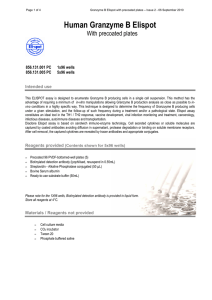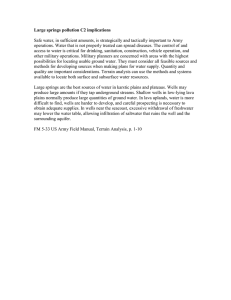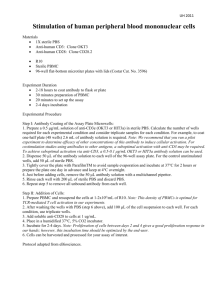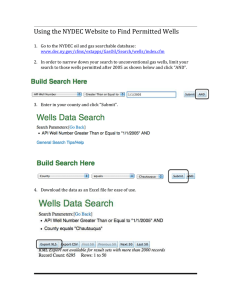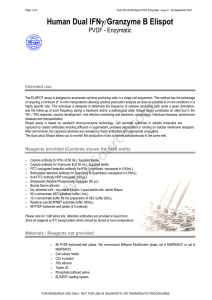GrB ELISPOT 0910 V5
advertisement
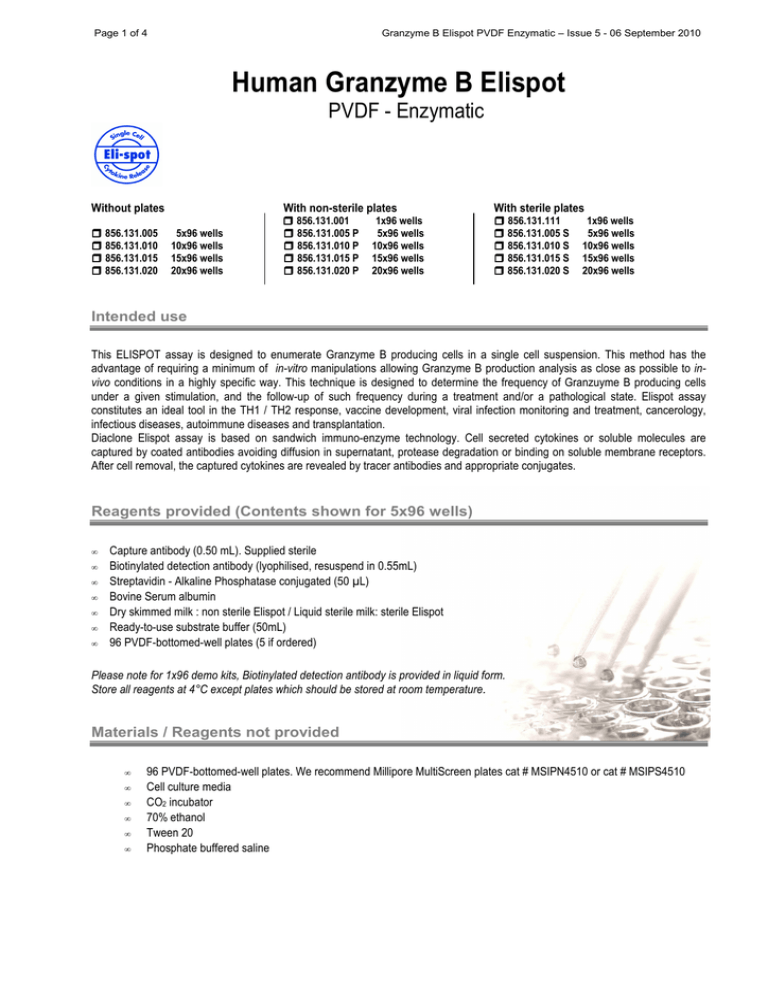
Page 1 of 4 Granzyme B Elispot PVDF Enzymatic – Issue 5 - 06 September 2010 Human Granzyme B Elispot PVDF - Enzymatic Without plates With non-sterile plates With sterile plates 856.131.005 856.131.010 856.131.015 856.131.020 856.131.001 856.131.005 P 856.131.010 P 856.131.015 P 856.131.020 P 856.131.111 856.131.005 S 856.131.010 S 856.131.015 S 856.131.020 S 5x96 wells 10x96 wells 15x96 wells 20x96 wells 1x96 wells 5x96 wells 10x96 wells 15x96 wells 20x96 wells 1x96 wells 5x96 wells 10x96 wells 15x96 wells 20x96 wells Intended use This ELISPOT assay is designed to enumerate Granzyme B producing cells in a single cell suspension. This method has the advantage of requiring a minimum of in-vitro manipulations allowing Granzyme B production analysis as close as possible to invivo conditions in a highly specific way. This technique is designed to determine the frequency of Granzuyme B producing cells under a given stimulation, and the follow-up of such frequency during a treatment and/or a pathological state. Elispot assay constitutes an ideal tool in the TH1 / TH2 response, vaccine development, viral infection monitoring and treatment, cancerology, infectious diseases, autoimmune diseases and transplantation. Diaclone Elispot assay is based on sandwich immuno-enzyme technology. Cell secreted cytokines or soluble molecules are captured by coated antibodies avoiding diffusion in supernatant, protease degradation or binding on soluble membrane receptors. After cell removal, the captured cytokines are revealed by tracer antibodies and appropriate conjugates. Reagents provided (Contents shown for 5x96 wells) • • • • • • • Capture antibody (0.50 mL). Supplied sterile Biotinylated detection antibody (lyophilised, resuspend in 0.55mL) Streptavidin - Alkaline Phosphatase conjugated (50 µL) Bovine Serum albumin Dry skimmed milk : non sterile Elispot / Liquid sterile milk: sterile Elispot Ready-to-use substrate buffer (50mL) 96 PVDF-bottomed-well plates (5 if ordered) Please note for 1x96 demo kits, Biotinylated detection antibody is provided in liquid form. Store all reagents at 4°C except plates which should be stored at room temperature. Materials / Reagents not provided • • • • • • 96 PVDF-bottomed-well plates. We recommend Millipore MultiScreen plates cat # MSIPN4510 or cat # MSIPS4510 Cell culture media CO2 incubator 70% ethanol Tween 20 Phosphate buffered saline Page 2 of 4 Granzyme B Elispot PVDF Enzymatic – Issue 5 - 06 September 2010 Principle of the method After cell stimulation, locally produced cytokines are captured by a specific monoclonal antibody. After cell lysis, trapped cytokine molecules are revealed by a secondary biotinylated detection antibody, which is in turn recognised by streptavidin conjugated to alkaline phosphatase. PVDF-bottomed-well plates are then incubated with BCIP/NBT substrate. Colored "purple" spots indicate cytokine production by individual cells. Procedure Summary Assay control Granzyme B production by PBMC upon stimulation by PHA. This protocol is given as a suggestion Dilute PBMC in culture media (e.g. RPMI 1640 supplemented with 2mM L-glutamine and 10% heat inactivated fetal calf serum) containing 10 µg/ml PHA (Sigma, Saint Louis, MO). Distribute 2.104 to 5.104 cells in antibody coated PVDF-bottomed-wells and incubate for 15-20 hours in an incubator. For other stimulators incubation times may vary, depending on the frequency of cytokine producing cells, and should be optimised in each situation. Page 3 of 4 Granzyme B Elispot PVDF Enzymatic – Issue 5 - 06 September 2010 Reagent Preparation Detection antibody Reconstitute the lyophilised antibody with 0.55mL of distilled water. Gently mix the solution and wait until all the lyophilised material is back into solution. If not used within a short period of time, reconstituted detection antibody should be aliquoted and stored at -20C°. In these conditions the reagent is stable for at least one year. Please note for the 1X96 wells, Biotinylated detection antibody is provided in liquid form. Streptavidin alkaline phosphatase Dilute 1/1000 in PBS 1% BSA. DO NOT KEEP THE DILUTIONS FOR FURTHER EXPERIMENTS Phosphate buffered saline (10X Concentrate solution). For 1 liter weight : 80g NaCl ; 2g KH2PO4 ; 14.4g Na2HPO4 2H2O. Add distilled water to 1 liter. Check that pH is comprised between 7.4 +/- 0.1. Dilute the solution to 1X before use. Skimmed milk in PBS For one non-sterile plate dissolve 0.2g of powder in 10mL of 1X PBS. For one sterile plate dilute 5ml of liquid milk in 5ml of 1X PBS. Please note liquid milk has a shorter expiration date than the other reagents of the kit (indicated on the vial). The use of expired milk can lead to unspecific stimulation. Use any fresh semi skimmed milk (UHT) if the one provided has expired. 1% BSA in PBS For one plate dissolve 0.2 g of BSA in 20 mL of 1X diluted PBS. 0.05% Tween in PBS For one plate dissolve 50µl of Tween 20 in 100 ml of 1X diluted PBS.. 35% ethanol in water For one plate mix 3.5 ml of ethanol with 6.5 ml of distilled water Elispot Procedure 1. Incubate PVDF-bottomed-well plates with 25µl / well of 35% ethanol for 30 sec at room temperature. 2. Empty wells and wash three times with 100µl / well of PBS. 3. Pipette 100µl of capture antibody in 10 mL of PBS. Mix and dispense 100 µl into each well, cover the plate and incubate overnight at +4°C. 4. Empty wells and wash once with 100 µl of PBS. 5. Dispense 100 µl of skimmed milk in PBS into wells, cover and incubate for 2 hours at room temperature. 6. Empty wells by flicking the plate over a sink and tapping it on absorbent paper. 7. Wash plate once with PBS. 8. Dispense into wells 100 µl of cell suspension containing the appropriate number of cells and appropriate concentration of stimulator. Cells may have been previously in-vitro stimulated (Indirect ELISPOT). Cover the plate with a standard 96-well plate plastic lid and incubate cells at 37°C in a CO2 incubator for an appropriate length of time (15-20 hours). During this period do not agitate or move the plate. 9. Empty wells by flicking the plate over a sink and gently tapping it on absorbent paper. 10. Distribute 100µl of PBS-0.05% tween 20 in wells and let sit for 10 min at +4°C. 11. Wash wells three times with PBS-0.05% tween 20. 12. For 1 plate dilute 100µl of reconstituted detection antibody into 10 mL of PBS containing 1% BSA. Distribute 100µl in wells, cover the plate and incubate 1 hour 30 min at 37°C. 13. Empty wells and wash three times with PBS-0.05% tween 20. 14. For 1 plate dilute 10µl of streptavidin-Alkaline phosphatase conjugate into 10 mL of PBS-1% BSA. Distribute 100µl of the dilution in wells. Seal the plate and incubate for 1 hour at 37°C. 15. Empty wells and wash three times with PBS-0.05% tween 20. Page 4 of 4 Granzyme B Elispot PVDF Enzymatic – Issue 5 - 06 September 2010 16. Peel off the plate bottom and wash three times both sides of the membrane under running distilled water. Remove all residual buffer by repeated tapping on absorbent paper. 17. Distribute 100µl of ready-to-use BCIP/NBT buffer in wells. 18. Let the reaction go for about 5-20 min at room temperature. Monitor spot formation visually. 19. Rinse three times both side of the membrane under running distilled water. 20. Dry wells. Read spots. Note that spots may become sharper after one night at +4°C. Store the plate at room temperature away from direct light. Notes and recommendations Cell stimulation 1. Cells can either be stimulated directly in the antibody coated wells (Direct) or, first stimulated in 24 well plates or flask, harvested, and then plated into the coated wells (Indirect). The method used is dependent on 1) the type of cell assayed 2) the expected cell frequency. When a low number of cytokine producing cells are expected it is also advised to test them with the direct method, however, when this number is particularly high it is better to use the indirect Elispot method. All the procedure beyond the stimulation step is the same whatever the method (direct/indirect) chosen. Substrate 2. BCIP/NBT buffer is potentially carcinogenic and should be disposed off appropriately . Caution should be taken while handling this reagent. Always wear gloves.
